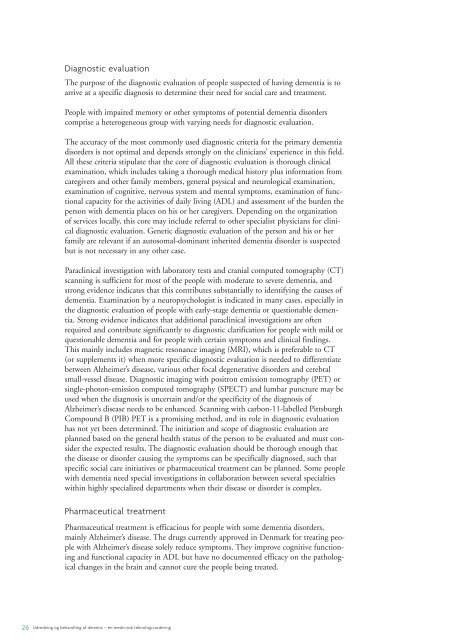Udredning og behandling af demens - Sundhedsstyrelsen
Udredning og behandling af demens - Sundhedsstyrelsen
Udredning og behandling af demens - Sundhedsstyrelsen
Create successful ePaper yourself
Turn your PDF publications into a flip-book with our unique Google optimized e-Paper software.
diagnostic evaluation<br />
The purpose of the diagnostic evaluation of people suspected of having dementia is to<br />
arrive at a specific diagnosis to determine their need for social care and treatment.<br />
People with impaired memory or other symptoms of potential dementia disorders<br />
comprise a heter<strong>og</strong>eneous group with varying needs for diagnostic evaluation.<br />
The accuracy of the most commonly used diagnostic criteria for the primary dementia<br />
disorders is not optimal and depends strongly on the clinicians’ experience in this field.<br />
All these criteria stipulate that the core of diagnostic evaluation is thorough clinical<br />
examination, which includes taking a thorough medical history plus information from<br />
caregivers and other family members, general psysical and neurol<strong>og</strong>ical examination,<br />
examination of c<strong>og</strong>nitive, nervous system and mental symptoms, examination of functional<br />
capacity for the activities of daily living (ADL) and assessment of the burden the<br />
person with dementia places on his or her caregivers. Depending on the organization<br />
of services locally, this core may include referral to other specialist physicians for clinical<br />
diagnostic evaluation. Genetic diagnostic evaluation of the person and his or her<br />
family are relevant if an autosomal-dominant inherited dementia disorder is suspected<br />
but is not necessary in any other case.<br />
Paraclinical investigation with laboratory tests and cranial computed tom<strong>og</strong>raphy (CT)<br />
scanning is sufficient for most of the people with moderate to severe dementia, and<br />
strong evidence indicates that this contributes substantially to identifying the causes of<br />
dementia. Examination by a neuropsychol<strong>og</strong>ist is indicated in many cases, especially in<br />
the diagnostic evaluation of people with early-stage dementia or questionable dementia.<br />
Strong evidence indicates that additional paraclinical investigations are often<br />
required and contribute significantly to diagnostic clarification for people with mild or<br />
questionable dementia and for people with certain symptoms and clinical findings.<br />
This mainly includes magnetic resonance imaging (MRI), which is preferable to CT<br />
(or supplements it) when more specific diagnostic evaluation is needed to differentiate<br />
between Alzheimer’s disease, various other focal degenerative disorders and cerebral<br />
small-vessel disease. Diagnostic imaging with positron emission tom<strong>og</strong>raphy (PET) or<br />
single-photon-emission computed tom<strong>og</strong>raphy (SPECT) and lumbar puncture may be<br />
used when the diagnosis is uncertain and/or the specificity of the diagnosis of<br />
Alzheimer’s disease needs to be enhanced. Scanning with carbon-11-labelled Pittsburgh<br />
Compound B (PIB) PET is a promising method, and its role in diagnostic evaluation<br />
has not yet been determined. The initiation and scope of diagnostic evaluation are<br />
planned based on the general health status of the person to be evaluated and must consider<br />
the expected results. The diagnostic evaluation should be thorough enough that<br />
the disease or disorder causing the symptoms can be specifically diagnosed, such that<br />
specific social care initiatives or pharmaceutical treatment can be planned. Some people<br />
with dementia need special investigations in collaboration between several specialties<br />
within highly specialized departments when their disease or disorder is complex.<br />
Pharmaceutical treatment<br />
Pharmaceutical treatment is efficacious for people with some dementia disorders,<br />
mainly Alzheimer’s disease. The drugs currently approved in Denmark for treating people<br />
with Alzheimer’s disease solely reduce symptoms. They improve c<strong>og</strong>nitive functioning<br />
and functional capacity in ADL but have no documented efficacy on the pathol<strong>og</strong>ical<br />
changes in the brain and cannot cure the people being treated.<br />
26 <strong>Udredning</strong> <strong>og</strong> <strong>behandling</strong> <strong>af</strong> <strong>demens</strong> – en medicinsk teknol<strong>og</strong>ivurdering

















